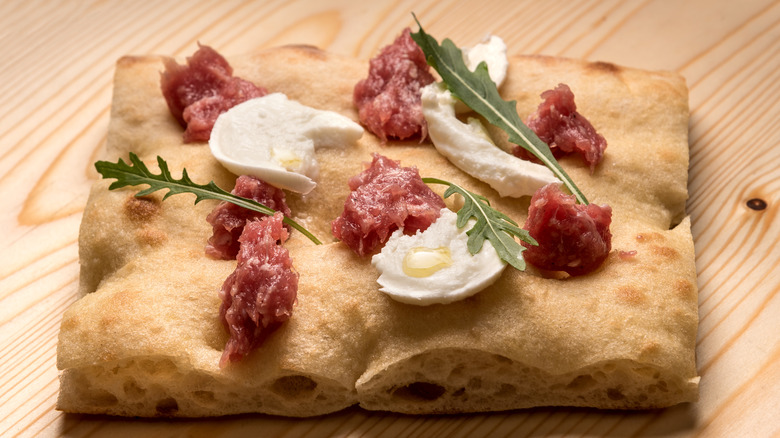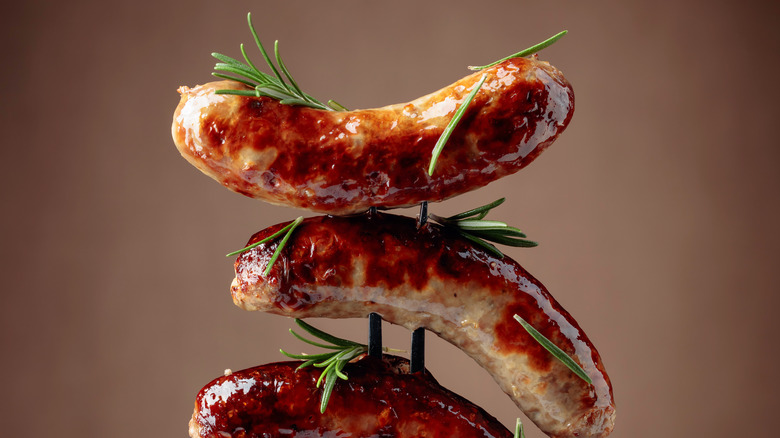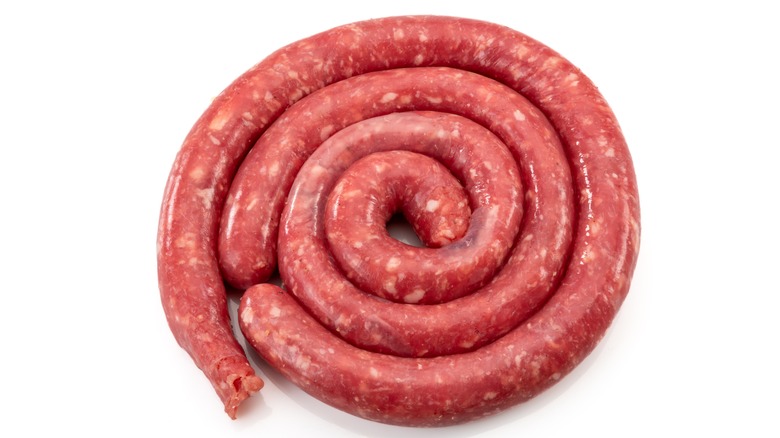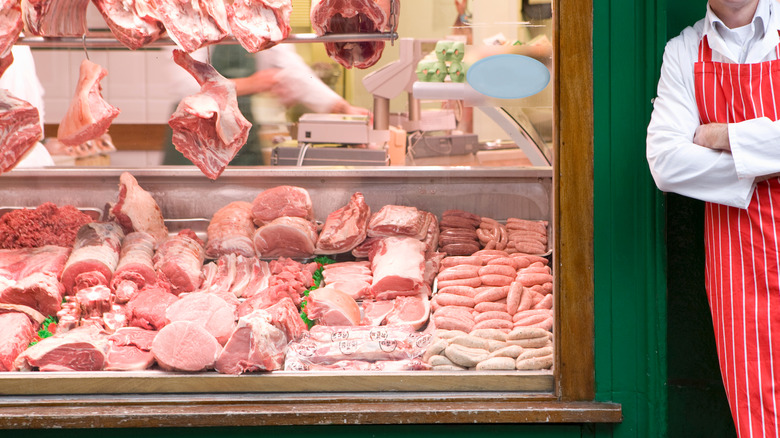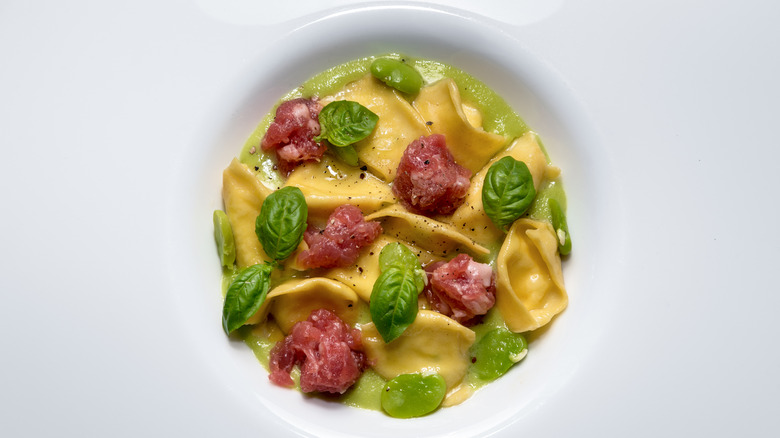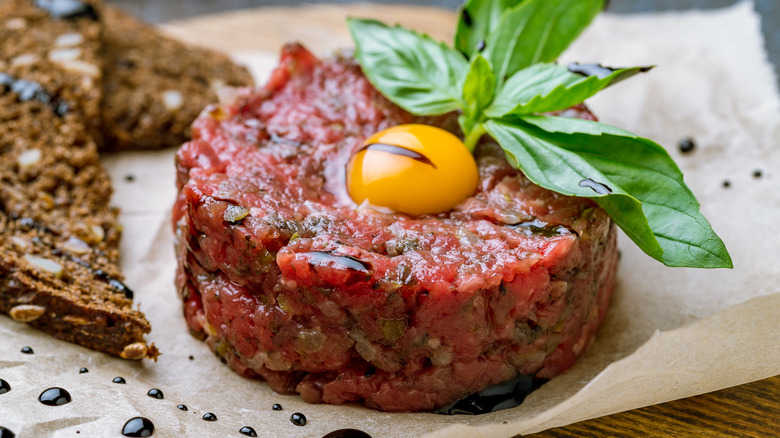Salsiccia Di Bra: The Traditional Italian Meat That's Eaten Raw
The sausages that end up on our plates have likely been pan-fried, roasted, or better yet charred by a smoky grill. There are a number of different types of sausage, all delicious in their different preparations. However, if you venture to northern Italy, you might be surprised to learn that there's a sausage that's best served raw. The delicacy is known as salsiccia di Bra and hails from a town rich in gastronomic heritage. Located in the Langhe region, Bra is known also for delights like the fresh or aged Bra DOP cheese and for being the birthplace of the Slow Food movement.
It might look like a standard sausage, but the vibrant pink hue of salsiccia di Bra indicates that it's made a bit differently, which is precisely why it can be enjoyed raw. Part of the Slow Food Ark of Taste, which aims to protect "endangered" food traditions (via La Stampa), the coiled wonder is definitely an acquired taste that's sure to pique the interest of crudo, carpaccio, and tartare fans. We've got you covered on all there is to know about salsiccia di Bra.
The origins of salsiccia di Bra
Salsicca di Bra is the only veal sausage to receive a royal license from King Carlo Alberto of Savoy in 1847 to protect its production, per Atlas Obscura. The use of beef was likely due to the fact that there once was a large Jewish community in the nearby town of Cherasco. Since pork is strictly forbidden for religious reasons, The Nosher states that sausages can only be made with meats like beef, lamb, or chicken in order to be deemed kosher. Hence, the use of veal.
Aside from the support of the Jewish community, locals also grew a fondness for the spiralized sausage. The demand inspired Bra butchers to continue production, each following a unique recipe that's since been passed down for generations, notes Kaataa. With a dedication to tradition, it's no surprise that the salsiccia continues to be additive-free, showcasing the quality of the local ingredients.
How the salsiccia is made
Salsiccia di Bra is a beef product — but not completely. Since beef fat goes rancid relatively quickly, Il Giornale del Cibo explains that the pearly white globules marbling the lean beef sausage are actually pockets of finely minced pork fat, which helps the sausage keep for longer periods of time.
According to Slow Food, the 80% veal and 20% pork base is then flavored with a unique blend of spices like sea salt, white pepper, mace, nutmeg, and cinnamon, with many producers opting to add fennel, garlic, leeks, a bit of cow's milk cheese, and a splash of local white wine (Arneis) for better consistency. The mix is then stuffed into a casing of lamb, sheep, or mutton intestine, notes Consorzio Tutela Salsiccia di Bra. The final product is a thin, coral-colored sausage with a soft and creamy texture and a delicately spiced, incredibly fresh flavor.
Salsiccia specifications
While salsiccia di Bra doesn't hold DOP status, it is considered a prodotto agroalimentare tradizionale (PAT), which recognizes the sausage as a traditional regional food. That said, the Consorzio Tutela Salsiccia di Bra explains that salsiccia di Bra can only be deemed as such if it follows certain criteria, including being made with Fassona beef and pork from farms located in the Piedmont region, and processed in the areas identified by the administrative boundaries of the Municipality of Bra. Likewise, Il Giornale del Cibo reports that cattle must also be fed a diet of cereals rather than standard animal feed as this will also affect the quality and flavor of the meat.
Since salsiccia di Bra is exclusively produced by a handful of qualified butchers in Bra — and because it's served raw — the only places where the sausage can be "exported" are nearby towns, making it a food that's common only to find around the region of Piedmont (via Edizioni Pubblicità Italiani).
How to eat salsiccia di Bra
Ask any Braidese how to eat salsiccia di Bra and they'll confirm that the best way to enjoy the sausage is to eat it raw. Although Dissapore reports on some of the debates surrounding how to eat the sausage, purists suggest that salsiccia di Bra should be eaten as is: raw, with the skin, and without additional seasonings like a splash of lemon or drizzle of olive oil.
You can grill it or use it in a ragù to top tajarin or agnolotti del Plin, but salsiccia di Bra makes the ideal offering for an antipasto course or as a snack for aperitivo. MamaBlip recommends serving the salsiccia with breadsticks or smeared on a slice of local bread and pairing with a glass of bubbly Alta Langa DOCG, Roero Arneis DOC, or a bold and spicy Dolcetto d'Alba DOC — wines which are all characteristic of the Langhe region.
Safety concerns
The thought of a raw sausage might seem like a cause for tummy troubles, but that isn't the case with salsiccia di Bra. Healthline notes that raw or undercooked pork is more susceptible to parasites, tapeworms, and other bacteria when compared to beef. But, because salsiccia di Bra is beef-based, it poses less of a risk — much like how eating a rare steak isn't considered too risky, either. When it comes to raw meats like tartare (or salsiccia di Bra), McGill outlines that these dishes face the strictest regulations, being processed by highly reliable butchers in a setting of extreme hygiene.
That said, time is of the essence when it comes to enjoying raw meat — fresher is always better. It's best to eat it the same day that you purchase the sausage, however, there is a tiny bit of wiggle room. According to Turismo di Bra, to ensure the best possible quality, salsiccia di Bra should be stored in the fridge and can be kept for a maximum of two days.
